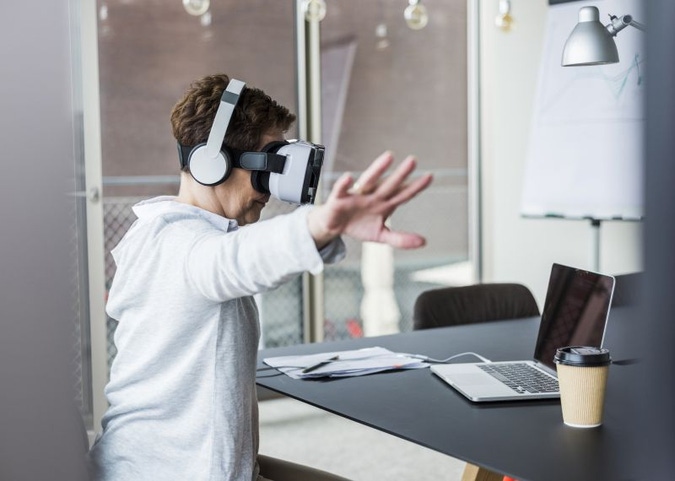12 Amazing Uses of Virtual Reality
From medicine to architecture, VR has proved to be a breakthrough technology for a variety of industries.

Opinions expressed by Entrepreneur contributors are their own.
Virtual reality technology holds enormous potential to change the future for a number of fields, from medicine, business, architecture to manufacturing.
Psychologists and other medical professionals are using VR to heighten traditional therapy methods and find effective solutions for treatments of PTSD, anxiety and social disorders. Doctors are employing VR to train medical students in surgery, treat patients’ pains and even help paraplegics regain body functions.
In business, a variety of industries are benefiting from VR. Carmakers are creating safer vehicles, architects are constructing stronger buildings and even travel agencies are using it to simplify vacation planning.
To make going to the dentist less painful.
Dentists may soon use virtual reality to distract patients and ease their anxiety and pain. A recent study tested 79 patients, outfitting one-third of them with a VR headset depicting a coastal scene, one-third with a VR cityscape and the remaining third with no VR at all.
Patients who experienced the VR coastal scene reported having “significantly less pain” than those in the other two groups. The patients who experienced the VR city did not feel this way — it was the calming scenery that helped distract and soothe the patients, not just the VR itself.
To train employees.
Walmart is using virtual reality to train its store employees. Partnered with virtual reality startup, STRIVR, Walmart uses virtual reality technology at its training academies to help employees experience real-world scenarios. Employees can experience a holiday rush or a mess in an aisle, and learn how to effectively respond and handle these events.
To help paraplegics regain body functions.
A year-long study conducted by Duke University discovered huge benefits of virtual reality technology for paraplegics.
To treat PTSD.
Traditionally, doctors use “exposure therapy” to treat the nearly 8 million adults who suffer from PTSD a year. Exposure therapy pushes patients to recount their traumas, visualize it in their imaginations and explain to the doctor what is happening as they experience the stressful scenario.
To train medical students.
Virtual reality provides medical and dental students a safe and controlled environment to practice surgeries and procedures, allowing them to make mistakes without having any impact on an actual patient, and prepare for any unexpected situations.
To treat pain.
Doctors are using “distraction therapy” through virtual reality to help people handle pain while they undergo treatments such as physical therapy. A 2011 study on military burn victims revealed that SnowWorld — a VR game that allows users to throw snowballs at penguins while listening to Paul Simon — has proven more effective than morphine in pain management.
U.K. researchers in 2017 tested VR on patients undergoing dental treatments and found its use simulating a coastal scene reduced both experienced and recollected pain compared with no VR. The VR was less effective when portraying an ubran scene, however.
To treat anxiety attacks.
More than 40 million adults in the U.S. experience anxiety. The virtual reality game Deep — “a digital version of a diaphragmatic exercise” — looks to help those individuals deal with fear and anxiety with the use of a belt that monitors breathing. The game puts the user into a natural setting and guides them through deep belly breathing exercises — calming users in about five minutes.
To help children and teens with autism develop social skills.
Professors at the University of Texas in Dallas have created a program that uses virtual reality to help children with autism develop social skills. Putting kids, teens and young adults in social scenarios such as job interviews or blind dates with avatars, they learn how to pick up on social cues and respond appropriately.
To help in business.
Look out video chat, virtual reality is here. Businesses are beginning to employ VR in a number of ways: to reduce costs, lessen business travel, conduct interviews, give tours, forecast trends and hold meetings.
Rather than traveling for a conference or meeting, or interviewing a candidate “face to face,” companies are using virtual conference rooms.
To better model architects’ designs.
Virtual reality will benefit key players in the construction space such as architects and designers. The tool allows a user to virtually inhabit spaces in three dimensions. Computer-generated images will replace hand-drawn renderings — ultimately reducing time spent reworking layouts and drawings, effectively reducing costs and increasing safety.
exit the buildingTo test car safety and drive sales.
VR gives cars engineers the ability to test the safety of vehicles in a virtual setting before actually manufacturing them. Aside from the building process, large car companies such as Ford, Volvo and Hyundai use virtual reality in sales as well by having potential customers use a VR headset to test drive vehicles.
To plan your next vacation.
You’ll soon be able to “try before you fly” destinations through virtual reality. Travelers looking to book their next trip can observe a destination, hotel or city to see what it has to offer. For example, patrons in a U.K. mall were able to experience a helicopter flight around New York City or a boat ride around the Statue of Liberty.
Virtual reality technology holds enormous potential to change the future for a number of fields, from medicine, business, architecture to manufacturing.
Psychologists and other medical professionals are using VR to heighten traditional therapy methods and find effective solutions for treatments of PTSD, anxiety and social disorders. Doctors are employing VR to train medical students in surgery, treat patients’ pains and even help paraplegics regain body functions.
In business, a variety of industries are benefiting from VR. Carmakers are creating safer vehicles, architects are constructing stronger buildings and even travel agencies are using it to simplify vacation planning.
The rest of this article is locked.
Join Entrepreneur+ today for access.
Already have an account? Sign In
 Cultura RM Exclusive/jackSTAR | Getty Images
Cultura RM Exclusive/jackSTAR | Getty Images Sam Edwards | Getty Images
Sam Edwards | Getty Images baranozdemir | Getty Images
baranozdemir | Getty Images MTMCOINS | Getty Images
MTMCOINS | Getty Images Caiaimage/Robert Daly | Getty Images
Caiaimage/Robert Daly | Getty Images valentinrussanov | Getty Images
valentinrussanov | Getty Images Dave and Les Jacobs | Getty Images
Dave and Les Jacobs | Getty Images MariaDubova | Getty Images
MariaDubova | Getty Images Westend61 | Getty Images
Westend61 | Getty Images Hero Images | Getty Images
Hero Images | Getty Images Caspar Benson | Getty Images
Caspar Benson | Getty Images Paolo Cipriani | Getty Images
Paolo Cipriani | Getty Images





